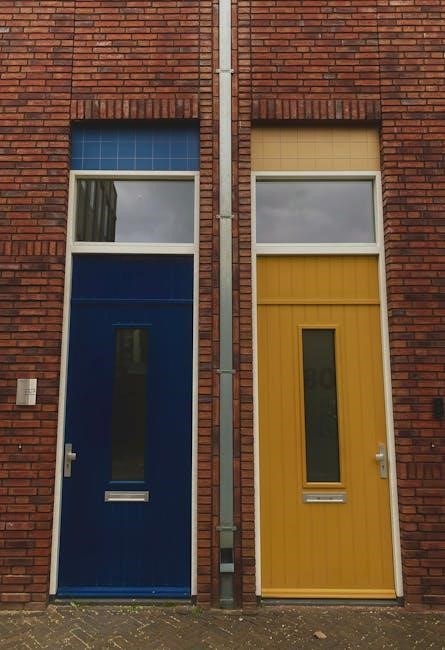The Template-Door-Modelbouw․pdf is a comprehensive guide offering detailed door templates for model building projects, ensuring precision and realism in miniature designs across various architectural styles and scales․
Overview of Door Templates in Model Building
Door templates are essential tools for model builders, providing precise patterns to craft realistic and detailed doors for various architectural styles․ These templates cater to both beginners and advanced modelers, offering designs that range from classic Victorian to sleek modern minimalist styles․ Available as downloadable PDFs, they ensure accuracy in scaling and proportions, making it easier to achieve professional-looking results․ Whether for miniature houses, historical replicas, or futuristic structures, door templates streamline the creation process, allowing builders to focus on intricate details and customization․ They are typically compatible with common materials like paper or cardstock and require basic cutting tools for assembly․ This versatility makes them a staple in every model builder’s toolkit, enhancing the authenticity and visual appeal of their projects․
Importance of Precision and Realism in Model Doors
Precision and realism are critical in model doors to maintain authenticity and visual appeal․ Accurate scaling ensures doors align proportionally with other architectural elements, preserving the model’s authenticity․ Even slight deviations can disrupt the overall aesthetic, making precise templates essential․ Realistic details like hinges, handles, and paneling enhance depth, drawing the viewer’s eye and adding complexity to the design․ Without attention to detail, models may appear incomplete or unrefined․ High-quality templates guarantee professional results, making precision a cornerstone of successful model building․ By focusing on these aspects, modelers can create doors that stand out, contributing to the overall realism and charm of their structures․

Key Features of the Template-Door-Modelbouw․pdf
The Template-Door-Modelbouw․pdf offers comprehensive design elements, technical drawings, and precise dimensions for creating realistic doors․ It supports various architectural styles and provides customizable options for unique projects․
Comprehensive Design Elements for Realistic Doors
The Template-Door-Modelbouw․pdf provides a wide range of design elements to craft highly realistic doors for model buildings․ From intricate Victorian-style carvings to sleek modern minimalist lines, the templates cater to diverse architectural preferences․ Detailed panel designs, ornate frames, and precise hardware placements ensure authenticity․ The guide includes scalable vectors, allowing users to adjust door sizes and details without losing clarity․ Materials like cardstock, foam board, and balsa wood are recommended for durability and realistic textures․ Step-by-step instructions guide users through cutting, layering, and assembling doors with precision․ Whether for historical replicas or contemporary structures, these templates offer the flexibility to customize and enhance doors with paint, weathering effects, and small hardware details, ensuring professional-level realism and visual appeal in every project․
Technical Drawings and Dimensions for Accuracy
The Template-Door-Modelbouw․pdf includes precise technical drawings and dimensions to ensure accuracy in crafting realistic model doors․ Detailed measurements and scalable templates allow users to achieve proper proportions for various architectural styles․ The guide provides clear instructions for adjusting door sizes to fit specific projects, ensuring consistency and realism․ Technical specifications cover frame dimensions, hinge placements, and panel alignments, making it easier to assemble doors accurately․ compatibility with materials like cardstock, foam board, and balsa wood is highlighted, offering durability and ease of shaping․ The templates also include markings for hardware installations, such as handle and lock placements, ensuring a polished finish․ These technical details empower model builders to create doors that align seamlessly with their structures, enhancing the overall authenticity and visual appeal of their projects․
Compatibility with Various Architectural Styles
The Template-Door-Modelbouw․pdf offers door templates designed to complement a wide range of architectural styles, from Victorian to modern minimalist designs․ This versatility ensures that model builders can create doors that seamlessly integrate into diverse structures, whether historical, contemporary, or fantastical․ The templates include scalable designs, allowing for adjustments to fit various scales and project requirements․ Customization options enable users to adapt door styles to match specific architectural themes, ensuring consistency and authenticity․ Compatibility with materials like cardstock, foam board, and balsa wood further enhances flexibility, making it easy to craft durable and realistic doors for any model building project․ This adaptability makes the templates a valuable resource for builders aiming to achieve a cohesive and visually appealing design across different architectural styles․
Popular Door Styles in Model Building
The Template-Door-Modelbouw․pdf features diverse door styles, including Victorian, modern minimalist, and customizable designs, adaptable to various scales and architectural themes for both historical and contemporary model structures․
Victorian-Style Doors: Intricate Details and Classic Proportions
Victorian-style doors are renowned for their intricate details and classic proportions, making them a popular choice for historical and vintage-themed model buildings․ These templates feature arched tops, multi-panel layouts, and ornate carvings, capturing the elegance of the Victorian era․ Ideal for scale models of period homes, shops, or public buildings, they provide precise measurements and cutouts for accurate assembly․ Made from durable materials like cardstock or thin wood, they can be painted or weathered to enhance realism․ Customizable options allow modelers to adjust sizes or details to fit specific projects․ Whether for a grand mansion or a quaint cottage, Victorian-style door templates bring a touch of timeless sophistication to any model structure, ensuring authenticity and visual appeal․

Modern Minimalist Doors: Clean Lines and Functional Design
Modern minimalist doors are characterized by clean lines, simplicity, and functional design, making them ideal for contemporary model buildings such as apartments, offices, or sleek residential structures․ These templates emphasize straight edges, flat surfaces, and minimal detailing, providing a versatile base for customization․ Modelers can enhance these designs by adding subtle details like handle insets or narrow frames while maintaining their minimalist aesthetic․ The templates are adaptable to various scales, ensuring compatibility with both small and large model projects․ Their neutral and timeless design allows for easy integration into diverse architectural styles, from urban lofts to minimalist homes․ With precise measurements and durable materials like cardstock or foam board, modern minimalist doors offer a polished and professional look, perfect for creating a sleek, contemporary feel in any model structure․

Customizable Door Templates for Unique Projects
Customizable door templates offer unparalleled flexibility for model builders seeking unique designs tailored to their projects․ These templates allow for precise adjustments to door styles, dimensions, and intricate details, making them ideal for historical, fantasy, or bespoke models where standard designs may not fit․ By modifying dimensions and adding custom elements, modelers can create one-of-a-kind doors that enhance their model’s authenticity․ Many templates come with scalable vectors, ensuring clarity at any size․ This flexibility makes them ideal for both novice and advanced builders, offering endless possibilities to match specific themes or architectural requirements․ With customizable options, doors can reflect the unique character of the model they adorn, ensuring structural integrity and visual appeal while maintaining precision and realism․
Essential Tools for Working with Door Templates
A high-quality printer, precision craft knives, cutting mats, rulers, and hobby knives are essential tools for accurately cutting and assembling door templates, ensuring clean cuts and precise details․
High-Quality Printer for Crisp Details
A high-quality printer is essential for producing crisp, detailed door templates․ It ensures that intricate designs, such as Victorian carvings or minimalist lines, are clearly visible and accurately scaled․ When selecting a printer, opt for one with high resolution to maintain sharpness, especially for small-scale models․ A printer capable of handling larger paper sizes, like A3 or A4, is ideal for bigger templates․ Always use the correct print settings to avoid pixelation or blurry edges․ Print a test page to verify alignment and proportions before final printing․ Durable materials like cardstock or high-quality paper are recommended for long-lasting results․ A reliable printer is the foundation for achieving professional-looking model doors with precise details and realistic finishes․
Precision Craft Knives for Clean Cuts

Precision craft knives are indispensable for achieving clean, precise cuts when working with door templates․ A sharp blade ensures smooth edges and prevents tearing, especially on intricate designs․ Hobby knives or X-Acto knives are ideal due to their fine tips and interchangeable blades․ Always use a cutting mat to protect your work surface and maintain control․ For detailed work, opt for a knife with adjustable depth settings to avoid cutting too deeply․ Regularly replacing dull blades is crucial for maintaining accuracy and preventing accidents․ When cutting layered templates, a precision knife allows for precise alignment and separation of components․ Clean cuts are vital for realistic and professional-looking model doors, making a high-quality craft knife a must-have tool in your toolkit․
Cutting Mats and Rulers for Accurate Measurements
Cutting mats and rulers are essential tools for achieving accurate measurements and cuts when working with door templates․ A high-quality cutting mat provides a protective, non-slip surface, ensuring your work stays stable during cutting․ This prevents damage to both the template and your tools․ Rulers, especially metal ones, offer precise straight edges for aligning cuts and measuring materials․ They are crucial for maintaining consistency, especially when scaling or adjusting template proportions․ A cutting mat also helps prevent accidents by cushioning the cutting surface, reducing the risk of knife slips․ Together, these tools ensure that every cut is clean, precise, and accurately measured, which is vital for creating professional-looking model doors that fit seamlessly into your designs․

Materials for Durable and Realistic Model Doors
Cardstock, foam board, and balsa wood are ideal materials for model doors, offering durability and realism․ Each provides unique benefits, ensuring long-lasting and visually appealing results in your projects․
Cardstock for Detailed Designs
Cardstock is an excellent choice for creating detailed and durable model doors due to its thickness and rigidity․ It holds intricate designs well and maintains shape when cut and layered․ Available in various weights, it offers versatility for different scales and styles․ For best results, print templates on high-quality cardstock using a precise printer to ensure crisp details․ After cutting, sand edges for smoothness and paint or weather for realism․ Cardstock is ideal for Victorian-style doors with ornate details or modern minimalist designs requiring clean lines․ Its durability ensures long-lasting results, making it a preferred material for model builders seeking both detail and strength in their creations․ Properly finished cardstock doors enhance the authenticity and visual appeal of any model structure․
Foam Board for Lightweight Yet Durable Options
Foam board is a versatile and lightweight material ideal for creating durable model doors․ Its dense, smooth surface is easy to cut and shape, making it perfect for intricate details and layered designs․ Unlike cardstock, foam board provides a more three-dimensional appearance while remaining lightweight, reducing the risk of warping or bending․ It is particularly suitable for modern minimalist doors, where clean lines and flat surfaces are essential․ To achieve the best results, use sharp blades or precision knives to avoid tearing the material․ Paint and finishes adhere well to foam board, allowing for realistic textures and colors․ Its durability ensures long-lasting model doors that maintain their shape and detail over time, making foam board a popular choice for both beginners and experienced model builders․ Properly finished foam board doors add depth and realism to any model structure․
Balsa Wood for Realistic Textures and Easy Shaping
Balsa wood is an excellent material for creating realistic and detailed model doors due to its natural texture and ease of shaping․ Its soft, lightweight, and porous structure allows for precise carving and sanding, making it ideal for intricate designs․ Balsa wood can be stained or painted to mimic real wood grain, adding authenticity to Victorian-style or rustic doors․ It is also highly adaptable, suitable for both small-scale and larger model projects․ When working with balsa wood, use sharp tools to avoid splintering and sand smoothly for a polished finish․ While durable enough for model doors, it remains lightweight, ensuring the structure remains balanced․ Its versatility and realistic appearance make balsa wood a popular choice for model builders seeking authentic textures and easy customization․

Printing and Preparing Door Templates
Ensure accurate printing by using high-quality paper or cardstock and proper scaling․ Print templates at the correct size to maintain proportions and achieve crisp details for realistic model doors․
Scaling Templates for Proper Proportions
Accurate scaling is crucial for ensuring door templates fit seamlessly into your model structure․ Use high-quality printers to maintain clarity and avoid resizing, which can distort proportions․ Print templates at the correct scale to match your model’s size, ensuring alignment with other architectural elements․ For intricate details, use a metal ruler or digital tools to verify measurements․ Avoid scaling errors by printing a test page first to confirm proportions․ Proper scaling ensures realistic and professional-looking results, maintaining the model’s authenticity and visual appeal․ This step is essential for achieving precise and visually consistent door designs in your model building projects․
Choosing the Right Paper or Cardstock
Selecting the appropriate paper or cardstock is vital for creating durable and realistic model doors․ Cardstock is ideal for detailed designs due to its thickness and rigidity, ensuring crisp lines and professional finishes․ For lightweight yet sturdy options, foam board is a great alternative, offering ease of shaping and durability․ Balsa wood is another excellent choice, providing realistic textures and easy manipulation for intricate details․ Consider the scale and desired finish of your model when choosing materials․ High-quality paper or thin plastic sheets can also achieve a smooth, realistic appearance․ Always opt for materials that align with your project’s needs, ensuring longevity and visual appeal․ Proper material selection enhances the authenticity and structural integrity of your model doors, making them a standout feature in your creations․
Assembly and Integration of Model Doors
Assembly involves cutting and layering components precisely, ensuring proper alignment with the model structure․ Secure parts with adhesive for stability, achieving a seamless integration into the design․
Cutting and Layering Techniques for Realistic Assembly
Accurate cutting is essential for realistic assembly․ Use sharp craft knives or precision cutters to follow template edges, ensuring clean, precise cuts․ Layering techniques involve assembling door components step-by-step, starting with the frame and adding panels or details․ Sand edges for smoothness and align parts carefully to maintain proportions․ For intricate designs, separate layers can be cut and stacked to create depth․ Apply adhesive sparingly to avoid warping or bulging․ Allow each layer to dry before adding the next, ensuring stability․ This method enhances realism by mimicking real-world door construction․ Proper layering also allows for customization, such as adding hardware or textures․ By following these steps, modelers can achieve professional-looking doors that blend seamlessly into their structures․
Aligning Doors with Model Structures
Proper alignment of doors with model structures is crucial for a cohesive and authentic appearance․ Begin by scaling the door template to match the overall size of your model, ensuring consistency in style and era․ Use reference images to verify the door’s placement and alignment within the structure․ Once scaled, attach the door frame securely, using a ruler or digital tool for precise alignment․ Ensure the door aligns with surrounding walls and floors for a seamless fit․ Misalignment can disrupt the model’s aesthetic, making it appear disjointed․ Proper integration enhances the model’s authenticity and visual appeal, drawing attention to detail and craftsmanship․ This step elevates the model’s overall quality, ensuring a professional and realistic finish․

Customization and Enhancement
Explore various materials, finishes, and advanced techniques to enhance your model doors, adding depth and realism to your creations while maintaining architectural authenticity and visual appeal․
Adding Hardware Details Like Hinges and Handles
Adding hardware details such as hinges, handles, and knockers enhances the authenticity and visual appeal of model doors․ These small elements can be crafted from materials like metal, plastic, or 3D-printed parts․ For Victorian-style doors, consider ornate metalwork or brass fixtures, while modern designs might feature sleek, minimalist handles․ Proper scaling is crucial to ensure these details align with the door’s proportions․ Use reference images to guide your selections and ensure accuracy․ Attach hardware securely using glue or tiny screws, and weather them to simulate aging or wear․ Optional additions like doorbells, mail slots, or keyholes further customize the look․ These intricate details transform a plain door into a focal point, capturing the essence of the model’s architectural style and adding depth to the design․
Painting and Weathering Techniques for Authenticity
Painting and weathering techniques are essential for achieving lifelike model doors․ Start with a base coat of acrylic paint, matching the door’s style and era․ Victorian doors look stunning in rich, bold colors, while modern designs benefit from neutral tones․ Add depth with shading and highlights to create a three-dimensional effect․ Weathering techniques like dry-brushing or washes can simulate wear, such as peeling paint or rusted hinges․ For a vintage look, apply subtle streaks or stains․ Metallic accents, like brass or chrome, enhance hardware details․ Use a clear varnish to protect the finish․ These methods add character and realism, making doors stand out in any model structure․ Avoid over-weathering, as it can detract from the design․ Proper painting and weathering ensure a professional, authentic appearance for your model doors․

Layering and Texturing for Depth and Realism
Layering and texturing are crucial techniques for adding depth and realism to model doors․ By incorporating multiple layers, such as frames, panels, and hardware, doors gain a three-dimensional appearance․ Texture can be achieved using materials like foam board for subtle relief or cardstock for intricate details․ Adding grained textures mimics real wood, while smooth surfaces can represent metal or glass․ Hardware details, such as hinges and handles, further enhance authenticity․ Layering also allows for customization, enabling modelers to create unique designs that suit various architectural styles․ Properly applied textures and layers ensure the door blends seamlessly with the model structure, creating a cohesive and visually appealing result․ These techniques elevate the model’s realism, making it stand out as a professional-grade creation․
The Template-Door-Modelbouw․pdf is an invaluable resource for model builders, offering precise templates and expert tips to craft realistic and detailed doors, enhancing any architectural style with authenticity and professionalism․
The Template-Door-Modelbouw․pdf serves as a detailed guide for creating realistic and precise model doors, catering to various architectural styles and scales․ It offers a wide range of door templates, from intricate Victorian designs to modern minimalist styles, ensuring versatility for different projects․ The guide emphasizes the importance of accuracy and realism, providing technical drawings, dimensions, and design elements to help modelers achieve professional results․ It also covers essential tools, such as high-quality printers and precision craft knives, and recommends durable materials like cardstock and foam board․ Customization options, including hardware details and weathering techniques, are highlighted to enhance authenticity․ By following the guide, model builders can craft doors that seamlessly integrate into their structures, adding depth and realism to their creations․ This resource is ideal for both beginners and advanced modelers seeking to elevate their projects with detailed, realistic doors․
Final Tips for Achieving Professional Results

To achieve professional results with the Template-Door-Modelbouw․pdf, ensure accurate scaling and alignment during printing and assembly․ Use high-quality materials like cardstock or foam board for durability and crisp details․ Invest in precision tools, such as craft knives and cutting mats, to achieve clean cuts and precise measurements․ Add realistic touches like hinges, handles, and weathering effects to enhance authenticity․ Print templates on the correct paper or cardstock to maintain clarity and proportions․ Avoid rushing the assembly process, as patience ensures a polished finish․ Finally, experiment with customization options to tailor doors to your project’s unique style․ By following these tips, you can create model doors that stand out for their realism and craftsmanship, elevating your entire model-building project to a professional level․